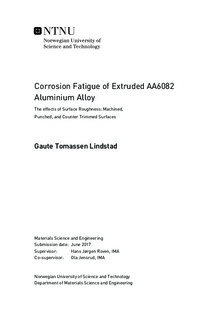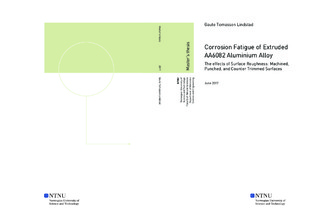| dc.description.abstract | The aim of this master s thesis is to investigate the corrosion fatigue properties of an extruded AA6082 alloy. Surface roughness deeply affects fatigue and corrosion fatigue. Surface roughness depends on the shaping process. Three shaping processes have been studied: machining, punching, and counter trimming. Counter trimming is a two-punch process, with the second punch coming from the opposite direction to the first punch. These shaping processes have very different surfaces and surface roughness. Corrosion fatigue tests has been executed with constant amplitude loading, R = 0.1, and with samples submerged in a 5wt% NaCl water solution.
Every sample which were punched or counter trimmed, and tested in saltwater, were optically scanned prior to testing. The topography and surface roughness are therefore thoroughly accounted for. To account for fracture initiation, the minimum of four samples from each process were studied in SEM. Some additional samples tested in air were investigated in SEM as well. Corrosion rates, temperature, and humidity were also accounted for.
The fatigue and corrosion fatigue life ranked as following: Machined > Counter trimmed > Punched. The difference between the processes were reduced when tested in saltwater. Fractography showed that the wounds created during punching and counter trimming were responsible for fracture initiation. For the machined series, the corners between the extruded and machined edge were responsible. The fracture surfaces had clearly visible grain boundaries in SEM. This was attributed to corrosion.
The machined surface showed a far superior surface roughness, with very low Ra, Rt, Rz, and Rv values. Rv proved to be very accurate predicting which side of a sample would have fracture initiation. Topography also showed that the punching parameters used for the samples tested in this thesis were not ideal. Using the difference in corrosion rates between the different surfaces, the increase in surface area due to punching and counter trimming was determined. Compared to the machined surface, the punched and counter trimmed surface had an increase of surface area equal to a factor of 2.55 and 2.41, respectively. | |

